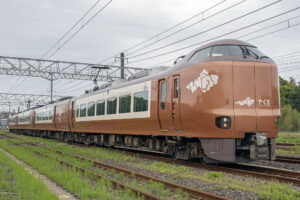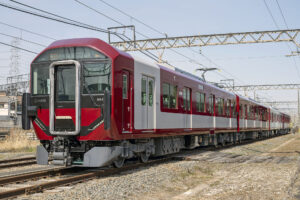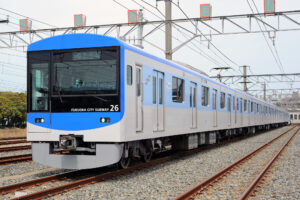JRC 2025 Blue Ribbon Prize and Laurel Prize
May 22, 2025
Japan Railfan Club, President Hiroshi Saeki, approximately three thousand members, awarded 2025 Blue Ribbon Prize to West Japan Railway Company series 273 as the most excellent rolling stock.
Also, Kintetsu Railway Co.,Ltd.’s series 8A and Fukuoka City Transportation Bureau Series 4000 have chosen 2025 Laurel Prize as excellent rolling stock.
These awards were decided by the Blue Ribbon Prize & Laurel Prize Selection Committee of JRC (BR&LPSC). Also Blue Ribbon Prize chosen based on the club member’s vote as the best rolling stock, while Laurel Prize chosen by discussion of BR&LPSC members as recognizing excellence equipment.
“The 68th” Blue Ribbon Prize
West Japan Railway Company series 273
“The 65nd” Laurel Prize
Kintetsu Railway Co.,Ltd.’s series 8A
“The 65nd” Laurel Prize
Fukuoka City Transportation Bureau Series 4000
Blue Ribbon Prize
West Japan Railway Company series 273
This is a new type of car developed as a successor to the Series 381 pendulum type limited express train, which has been used as the “Yakumo” limited express train for over 40 years. The design was developed in a workshop involving designers and JR West employees, and is characterized by its uniqueness, which is different from existing limited express trains.
The exterior is “Yakumo Bronze,” an original color that “respects the nature, scenery, culture, and history of the railway line and communicates with customers,” and the symbol mark “Yakumo stands modernly, inheriting traditions” is placed. The interior of the Green Car has a warm color tone with a piled stone tortoiseshell pattern, while the seats of the standard car have a cool color tone with a hemp leaf pattern, wood grain walls, and indirect lighting. In addition, seat pitch in standard cars is 1040 mm, the same as in Shinkansen trains, and new semi-compartments for 2 and 4 passengers and free space have been provided, and wheelchair space complies with the latest mobility facilitation standards.
The train consists of four electric cars with single bogie drive. The body is double-skinned aluminum, with crash protection measures in various parts in keeping with existing cars. The cross section of the car has a low roof and narrowed upper and lower sides to accommodate the sloping body and lowered center of gravity.
The pendulum controller, newly developed with the Railway Research Institute and Kawasaki Rolling Stock, performs high-precision position recognition based on map data of the track geometry and measurements from running speed and gyro sensors, and together with actuators for body inclination with improved response, optimizes inclination control to match the track geometry for improved ride comfort.
In the drive system, two 220kW totally enclosed induction motors are controlled by a full-SiC inverter. The auxiliary power unit is also a full-SiC 75kVA power unit, and the output of each car is connected in parallel to enable the train to continue operation even in the event of a breakdown. The brake system is an electric command type with regenerative braking and is controlled on a car-by-car basis. The vehicle information control system for control commands and monitoring is an Ethernet system with a transmission speed of 100 Mbps. In addition, an abnormal vehicle behavior detection system detects derailments, etc., to ensure safety and reliability.
Laurel Prize
Kintetsu Railway Co.,Ltd.’s series 8A
The Kinki Nippon Railway Series 8A is the company’s first new general-purpose train in 24 years, and is intended to replace the large number of general-purpose trains manufactured in the 1960s and 1970s that are still in service. The first 4-car trains are for the Nara and Kyoto Lines, and will operated from October 2024. Future expansion is planned for the Osaka Line, Nagoya Line, and Minami Osaka Line. The train type has a new five-digit numbering system, with the most significant digit representing the main line section, and the next “A” representing the train series.
The car body is a 20-meter class 4-door, which is the standard for the company’s general-purpose cars. The aluminum body structure is the first to realize a width of 2,800 mm without a hemstitch, and is being widened to the limit in the operational areas. The front of the car has a distinctive octagonal shape, with slanted LED front lights at the bottom and a large type destination indicator and sign lights at the top. In addition, it is equipped with through doors and a fall-preventing outer canopy, and is designed to handle offset collisions. The two-tone red and white color scheme has been retained, while new shades and paint patterns have been adopted.
The passenger compartment is equipped with L/C seats between the doors, and long and cross modes can be set for each block between the doors, allowing for flexible operation according to congestion conditions. In addition, two “Yasashiba” means gentle space, sets by the center door of each car are equipped with seats that can be used both vertically and horizontally to accommodate strollers, large luggage, and a variety of other needs. Above the doors is a large 42-inch half LCD display, one of the largest in Japan. The cabin design is based on the concept of “everyday glamour,” and as a new standard for the company’s rolling stock, it is also being horizontally deployed in the renewal work of conventional cars.
The control system is inverter-controlled with hybrid SiC elements, and the brake system is an electric command type with speed suppression and regeneration. In addition, the reading device and the brake tube are drawn through to enable flexible operation in combination with conventional cars of various control and brake systems.
The Series 8A was selected for the Laurel Award because of its high approval rating in the voting by members, and because of its extremely high versatility and flexibility of operation and high level of cabin service as the next-generation general-purpose railcar for the company, while aiming for new standardization.
Laurel Prize
Fukuoka City Transportation Bureau Series 4000
The Fukuoka City Transportation Bureau Series 4000 is designed to replace the Series 1000N on the Airport Line and Hakozaki Line. The design concept of the Series 4000 is “a travel space friendly to each and every person”, and the design points to achieve this are “high quality service”, ‘quietness’, “safety and security”, and “energy saving and maintenance”.
The exterior of the train features a gabled front with a rounded paint scheme and a “blue” color that continues into a line at the top of the side of the car body, as well as “sky blue” around the side windows, which is reminiscent of the “sky” of Fukuoka Airport. The car body is an aluminum double-skin structure.
The car body is made of aluminum double-skin structure, and the seat width has been increased to 480mm per person, with increased handrails and handholds, and cargo racks lowered to eye level to create a comfortable and user-friendly interior space. The free space at the front of Car No. 6 has a large window to enjoy the sea view, with seating for one at both ends, and a luggage storage area on the mountain side for passengers using the airport, etc. The free space at the front of Car No. 6 has a large window to enjoy the sea view, with seating for one at both ends, and a luggage storage area on the mountain side for passengers using the airport, etc. The mountain side has two sets of two-seaters with luggage storage for passengers using the airport. Pictograms are displayed on the floor and walls of these areas to provide users with easy-to-understand information.
The bogies are air-spring-supported direct-mounted bolster bogies with a new single-axle steering mechanism in addition to the conventional sound-proof wheels, which provide a very quiet interior space. The equipment actively adopts the latest technology, and in particular, the world’s first synchronous reluctance motor, which does not require permanent magnets, has been adopted for the main electric motor, saving 40% energy compared to conventional cars. The integrated train management system controls each car and displays information on three screens in the cab, and also transmits information to the ground system to support crews, reduce downtime, and improve maintenance efficiency. A three-screen display with a two-screen integrated information display function is installed above each door. In addition, to improve onboard safety, an onboard camera mounted on some of the indicators constantly records images, which are linked to emergency call operations, etc., and can be automatically displayed on the driver’s cab and confirmed by the Transportation Control Center.
The Laurel Award was given to this next-generation subway car in recognition of its balanced combination of new design and technology with simple functional beauty and maximum consideration for passenger comfort.




